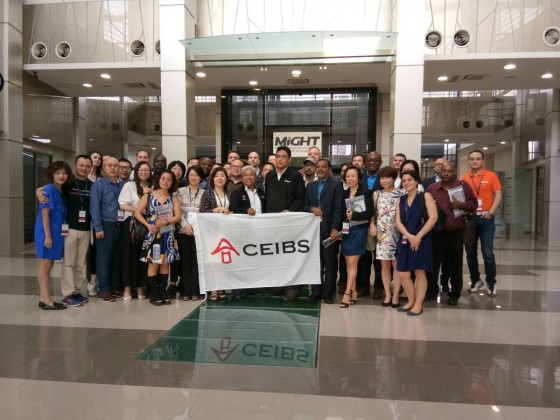Industry 4.0 brings about sustainable production as it is primarily driven by a fusion of once separate technologies that when joined together are integrating the physical and digital worlds. The scope of its impact applies primarily to manufacturing technologies and industries, and at the same time profoundly transforming our economies and societies.
The Global Science and Innovation Advisory Council (GSIAC) Secretariat aims to provide an alternate perspective of Industry 4.0 through Assessment on Industry 4.0, focusing on four main concerns which are Awareness, Talent Supply, Regulations and Potential Industry or Area. Interviews were carried out with relevant stakeholders to gauge the country’s level of readiness in facing Industry 4.0. The following are excerpt of interviews from the report.


♦♦ Khazanah is completely agreeable that Industry 4.0 could be a game changer for businesses and potentially will bring about disruptive changes to the society at large.
♦♦ Khazanah believes that Awareness is crucial at this juncture to ensure that all stakeholders are on the same page. For instance, currently within the Government, some ministries do understand the urgency to pursue Industry 4.0, while others are blissfully aware of the consequences of not taking cognisant of the potential impact of Industry 4.0.
♦♦ Besides awareness, Khazanah and their investee companies are also facing great challenges in integrating Industry 4.0 into their mainstream businesses. For example, banks are finding it difficult to integrate Fintech related technologies (such as Blockchain) and services into their mainstream banking and investment operations.
♦♦ With that, Khazanah believes in a 3-phase approach,
(i) create overall awareness;
(ii) get senior management (of investees) to acknowledge the importance of Industry 4.0; and
(iii) determine how to integrate Industry 4.0 into their mainstream businesses.

♦♦ Large corporations need to get on board, as they are sitting on large pools of data and not leveraging on it.

♦♦The Honeywell Operating System technology is driving Industry 4.0 in their plant’s productivity and efficiency.
♦♦ Honeywell practices cost-benefit analysis between Human and Robots, before deciding on investments into Industry 4.0.

♦♦Industry 4.0 represents a new way of doing business and transforming the landscape – it will be a business imperative for all industries.
♦♦ Oil & Gas is not far behind in implementing Industry 4.0 related industries. Blockchain technology is already being experimented with to increase efficiency for O&G trading.
♦♦ As for PETRONAS, the company is currently leveraging on Industry 4.0 technology to enhance operational excellence.
♦♦ CEO of PETRONAS feels strongly that Going Digital is important to the company.
♦♦ To become a truly digitally enabled organisation, PETRONAS is now initiating steps to advance beyond vertical implementation of Industry 4.0.
♦♦ Beyond that, PETRONAS will also continue doing its part to support service providers that employs Malaysians to cultivate local industry and talent.


♦♦ Talent issues need to be addressed, especially on STEM and English proficiencies, and for schools to inculcate curiosity, problem solving and technology seeking attitudes amongst their students. Efforts should be made to enable public schools to catch up with private schools.

♦♦ Khazanah believes that in Malaysia, there is a disconnect between the universities and the industries.
♦♦ Gaps exist between university researchers and the industries, and these gaps between the interests of researchers and needs of the industries need to be addressed.
♦♦ For research to be commercialised, there needs to be a combination of business acumen and technological knowhow. As such, incubator programmes need to address the need to link business partners with researchers in commercialising their research outcome.

♦♦ Getting the right talent is a challenge now, e.g., in machine learning.
♦♦ Start-up entrepreneurs aren’t usually from the field that they want to specialise in, and these specialisations are often not hired. But due to limited talents, start-ups lack the depth in understanding the businesses. E.g., Fintech entrepreneurs are not from the banking sector.
♦♦ Investees usually outsource their (product) development due to the lower costs and talent limitation internally.
♦♦ Hence, the issue is that the knowledge depth of talents is not there to undertake the kind of ventures that are being proposed.

♦♦ Developing a pool of Industry 4.0 service provider could be a solution to overcome the CAPEX and talent issues related to Industry 4.0 adoption.

♦♦ To ensure cohesive progress in this aspect, PETRONAS has a Chief Digital Officer for the group, who orchestrates the whole span of Industry 4.0 activities implemented by the group of companies.
♦♦ 52% of staff in PETRONAS is below the age of 35. As such, acceptance of Industry 4.0 is very high. Awareness of it is already very high among that peer group.

♦♦ Most SME complaints are from mom and pop shops. The scenario has changed and they need to do their business differently. SME Corp do have training programmes funded through HRDF.

♦♦ The industries have on many occasions expressed that local university graduates do not meet their job requirements or the skill sets they desire, but are unwilling to provide on the job training for fear of employees leaving after getting experience and certification.
♦♦ Recent initiatives fostering strong university and industry collaborations through programmes such as 2U2I and CEO@faculty can break the barriers.


♦♦ The Cabinet has decided to establish a high-level task force to develop a framework for Industry 4.0, and MITI is now in the process of formulating the policy framework with relevant inputs from various stakeholders.
♦♦ The objective of this policy framework is to position Malaysia as strategic partner for smart manufacturing and related services in Asia Pacific and primary destination for high tech industry offering total solutions for the whole ecosystem by 2030.
♦♦ The focus of this policy framework on Industry 4.0 is on manufacturing and manufacturing related services.
♦♦ MITI believes that Malaysia’s IP regime is relatively good now. However, there is a significant gap between research and commercialisation. One way of addressing this is by having incubators and working with the university eco-system. Commercial funding for research as a percentage of GDP is still low.

♦♦ Also mentioned were the approach of public research institutions in commercialising their research outcome. Most are currently relying on technology licensing, which is not easily achievable. Instead, they should encourage their researchers to just run with their research outcome through some form of startup venture.

♦♦ Fintech could be a regulatory challenge, as Malaysia is believed to be less open in Fintech related regulations as compared to Singapore and Indonesia.
♦♦ Funding will be an issue that needs to be addressed if the Government is serious about pushing for Industry
4.0.









